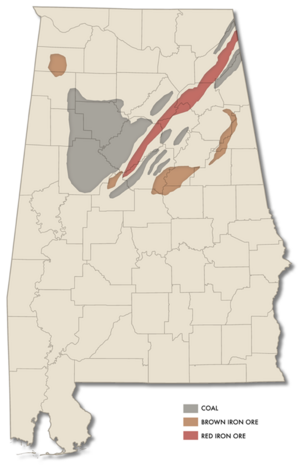Birmingham District: Difference between revisions
No edit summary |
No edit summary |
||
| (10 intermediate revisions by 2 users not shown) | |||
| Line 1: | Line 1: | ||
The '''Birmingham District''' refers to a | [[Image:Alabama minerals.png|right|thumb|300px|Map of coal and iron ore resources in Alabama]] | ||
The '''Birmingham District''' refers to a geological area in the vicinity of [[Birmingham]], [[Alabama]] where the raw materials for making [[steel]], [[limestone]], [[iron ore]], and [[coal]], are found together in abundance. The district includes [[Red Mountain]], [[Jones Valley]], and the [[Warrior coal field|Warrior]] and [[Cahaba coal field]]s in [[Central Alabama]]. | |||
The industrial development of these resources began, in limited fashion, before the [[Civil War]] (attracting the attention of [[Wilson's Raiders]] in the course of that conflict). | The industrial development of these resources began, in limited fashion, before the [[Civil War]] (attracting the attention of [[Wilson's Raid|Wilson's Raiders]] in the course of that conflict). | ||
Beginning in 1871 with the [[founding of the City of Birmingham]] and the construction of the first [[blast | Beginning in [[1871]] with the [[Founding of the City of Birmingham|founding of the City of Birmingham]] and the construction of the first [[List of furnaces|blast furnaces]], the development of the district enjoyed explosive growth, slowed only by a deficit of skilled labor and investment capital. This boom earned for Birmingham the nickname "The [[Magic City]]" and also spurred the growth of several independent industrial cities and dozens of [[company town|company towns]]. | ||
By the end of the 19th century, [[Birmingham]] was the third largest exporter of pig iron in the world, producing 3/4ths of United States exports. The region was also a major exporter of coal, and, as technology advanced, became a major steel producing district. With a few notable exceptions such as cast iron pipes and fittings, most of the district's economic output was in basic materials rather than in finished consumer products. | |||
As the steel-making industry has diminished in its economic importance to the district, many of the sites have been abandoned or dismantled. [[Industrial archaeology|Preservationists]] are attempting to document and preserve the physical evidence of Birmingham's industrial history. In the spring of [[1993]] a large-scale survey was undertaken for the [[Birmingham Historical Society]] and the [[Historic American Buildings Survey]]/[[Historic American Engineering Record]]. The results of that survey were published in the book ''[[Birmingham Bound]]''. | As the steel-making industry has diminished in its economic importance to the district, many of the sites have been abandoned or dismantled. [[Industrial archaeology|Preservationists]] are attempting to document and preserve the physical evidence of Birmingham's industrial history. In the spring of [[1993]] a large-scale survey was undertaken for the [[Birmingham Historical Society]] and the [[Historic American Buildings Survey]]/[[Historic American Engineering Record]]. The results of that survey were published in the book ''[[Birmingham Bound]]''. | ||
== See also == | |||
*[[Birmingham-Hoover Metropolitan Statistical Area]] | |||
==References== | ==References== | ||
* Armes | * {{Armes-1910}} | ||
* Lewis | * {{White-1981}} | ||
* {{Lewis-1994}} | |||
* Morris, Philip & Marjorie Longenecker White (1997) ''Birmingham Bound, An Atlas of the South's Premier Industrial Region''. Birmingham, Alabama: Birmingham Historical Society. ISBN 0943994225 | * Morris, Philip & Marjorie Longenecker White (1997) ''Birmingham Bound, An Atlas of the South's Premier Industrial Region''. Birmingham, Alabama: Birmingham Historical Society. ISBN 0943994225 | ||
==Source== | ==Source== | ||
Latest revision as of 14:12, 20 November 2010
The Birmingham District refers to a geological area in the vicinity of Birmingham, Alabama where the raw materials for making steel, limestone, iron ore, and coal, are found together in abundance. The district includes Red Mountain, Jones Valley, and the Warrior and Cahaba coal fields in Central Alabama.
The industrial development of these resources began, in limited fashion, before the Civil War (attracting the attention of Wilson's Raiders in the course of that conflict).
Beginning in 1871 with the founding of the City of Birmingham and the construction of the first blast furnaces, the development of the district enjoyed explosive growth, slowed only by a deficit of skilled labor and investment capital. This boom earned for Birmingham the nickname "The Magic City" and also spurred the growth of several independent industrial cities and dozens of company towns.
By the end of the 19th century, Birmingham was the third largest exporter of pig iron in the world, producing 3/4ths of United States exports. The region was also a major exporter of coal, and, as technology advanced, became a major steel producing district. With a few notable exceptions such as cast iron pipes and fittings, most of the district's economic output was in basic materials rather than in finished consumer products.
As the steel-making industry has diminished in its economic importance to the district, many of the sites have been abandoned or dismantled. Preservationists are attempting to document and preserve the physical evidence of Birmingham's industrial history. In the spring of 1993 a large-scale survey was undertaken for the Birmingham Historical Society and the Historic American Buildings Survey/Historic American Engineering Record. The results of that survey were published in the book Birmingham Bound.
See also
References
- Armes, Ethel (1910) The Story of Coal and Iron in Alabama. Birmingham: Birmingham Chamber of Commerce
- White, Marjorie Longenecker (1981) The Birmingham District: An Industrial History and Guide. Birmingham: Birmingham Historical Society ISBN 9990230099
- Lewis, W. David (1994) Sloss Furnaces and the Rise of the Birmingham District: An Industrial Epic. Tuscaloosa: University of Alabama Press. ISBN 0817307087
- Morris, Philip & Marjorie Longenecker White (1997) Birmingham Bound, An Atlas of the South's Premier Industrial Region. Birmingham, Alabama: Birmingham Historical Society. ISBN 0943994225
Source
- "Birmingham District." Wikipedia, The Free Encyclopedia. 11 Mar 2006, 14:08 UTC. 17 Mar 2006, 02:27 link.
